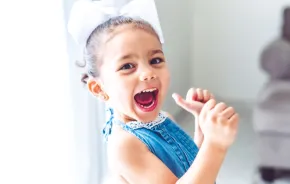 During our family’s first holiday season, our newly adopted 3-year-old daughter from China had never heard of Santa Claus, or Christmas for that matter. I’m not sure she even understood that the presents she opened were for her.
During our family’s first holiday season, our newly adopted 3-year-old daughter from China had never heard of Santa Claus, or Christmas for that matter. I’m not sure she even understood that the presents she opened were for her.
A month later, we attended a Chinese New Year festival, where we had a family picture taken amid streamers, drumming and other festivities. When our daughter looked at the picture, she didn’t need language to understand that this was our family. These days, our daughter understands all too well that Christmas means presents. We continue having our family photo taken on the Chinese New Year because it’s an annual tradition that isn’t about the gimmes, shopping and scheduling.
It takes a conscious effort to have meaningful holidays; developing your family’s own unique set of traditions can help.
Here are some ideas:
1. Give thanks.
Gratitude should be front and center, but in the rush of the holidays, rituals help make thankfulness happen. A simple tradition is for each person at the holiday table to make a statement of thanks: “This year I am most grateful for …” Sometimes the smallest voices at the table can surprise you, and hearing adults name their deepest thanks sets a great example of mindfulness and gratitude. ParentMap reader Kate Sigafoos says her family writes things they are grateful for on strips of paper that they make into a chain to decorate the table on Thanksgiving. Other families decorate with construction-paper leaves that have expressions of gratitude written on them.
2. “Catch” kindness.
 Jackie Bungard of Phoenix, Ariz., encourages kindness with cotton balls. Each time someone in the family is “caught” doing something kind or thoughtful during the holiday season, another cotton ball is placed under the baby Jesus in the crèche. By Christmas Eve, the baby rests in a soft bed of cotton. The practice brings attention away from the mall and back to the family’s faith, while the physical metaphor of making baby Jesus more comfortable makes an abstract concept concrete for small children.
Jackie Bungard of Phoenix, Ariz., encourages kindness with cotton balls. Each time someone in the family is “caught” doing something kind or thoughtful during the holiday season, another cotton ball is placed under the baby Jesus in the crèche. By Christmas Eve, the baby rests in a soft bed of cotton. The practice brings attention away from the mall and back to the family’s faith, while the physical metaphor of making baby Jesus more comfortable makes an abstract concept concrete for small children.
3. Teach generosity.
Growing up Muslim in Marysville, Wash., Natasha Habib didn’t celebrate Christmas. Instead, she and her family baked cookies for their Christian friends. The tradition helped her and her sisters feel part of the wider community while reinforcing the generosity that both faiths celebrate. There are many other ways to encourage generosity and kindness in kids. ParentMap reader Kate Williams involves her children in choosing items to donate on their grandparents’ behalf. Then they wrap up pictures of the donated items to give their grandparents.
4. Make gifts personal.
My mom still remembers the year her family gave up trying to buy gifts for all eight siblings. They drew names and set a price limit. Then, to keep things interesting, they decided not to label the gifts. Each gift had to reflect the personality of the recipient so clearly that it would be obvious who the gift was for without a tag. A common variation of the family gift exchange is to require that at least some gifts be handmade. The family can make simple gifts together for their community, such as hot cocoa mix or mixed nuts. ParentMap reader Melanie White’s family blows glass ornaments at a local studio. Even a preschooler can draw a picture for each family member.
5. Share the joy.
Small children don’t usually have money of their own to donate, but their energy and delight are gifts in themselves. A visit from a small child can make the day of someone who is working or alone during the holidays. Gather several families to sing carols at a retirement home, or have kids make cards for their letter carrier and garbage collectors.
6. Adopt a family from a giving tree.
Adopting a family from a giving tree makes a real difference to families in need. Each ornament on the giving tree contains a needy family’s entire Christmas list. These lists are usually short on toys and long on practical items, such as winter coats and warm shoes. My officemates pool their resources to adopt a family each year, but it would be a great project for extended families, too. Shopping can be very meaningful once children understand that giving up a few presents under the tree can mean all the presents under someone else’s. Local nonprofits with giving tree opportunities include the Pike Place Market Foundation, YWCA Seattle-King-Snohomish and The Salvation Army.
7. Pass it on.
Engage children in choosing (gently used) items from their toy boxes, bookshelves and closets to pass on to other kids — pausing to explain how much these items can mean to someone else. This kind of practice can help make giving real for kids. Older kids can take a leadership role in organizing a clothing, book, toy or food drive in the neighborhood or at their school. In the Seattle area, WestSide Baby and Treehouse are two great local organizations helping families and children that accept household items. The website Donation Town can help you locate a charity if you need someone to pick up the collected items.
8. Give experiences.
ParentMap reader Stella Shafer’s family limits gifts to stockings. They spend their money instead on renting a cabin with the extended family. Everyone values the time spent with cousins more than any present. Experience gifts can range from pricey — such as a family matinee to The Nutcracker or a gift certificate to Point Defiance Zoo’s new shark dive — to free, such as a Christmas Day hike, complete with hot cocoa in thermoses. While experience gifts can be a tough sell to little kids, helping them identify experiences they can give to others will help: Parents will love to receive invitations to a teddy bear tea party.
9. Donate labor.
While not every nonprofit has volunteer opportunities for families, fun educational opportunities for families to give back do exist. Locally, nonprofits addressing hunger, such as Food Lifeline and many food banks, offer opportunities for kids and families to volunteer together. You can also volunteer right at home by raising money for your favorite causes through creative fundraising options: Kids can help bake dog treats, braid rope toys and decorate picture frames for pet gift baskets. Or teams can assemble green cleaning kits by filling inexpensive spray bottles with vinegar and water, filling jars with baking soda, and tearing old towels for rags.
Check out the ParentMap website for more ways to help during the holidays.











